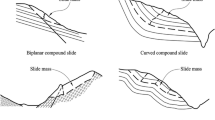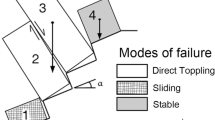Abstract
A thermally induced wedging–ratcheting mechanism for slope stability is investigated using a large-scale physical model and using a three-dimensional version of the numerical Distinct Element Method (3DEC). The studied mechanism consists of a discrete block that is separated from the rock mass by a tension crack filled with a wedge block or rock fragments. Irreversible block sliding is assumed to develop down a gently dipping sliding plane in response to climatic thermal fluctuations and consequent contraction and expansion of the sliding and wedge block materials. A concrete block assembly representing the rock mass is placed in a specially designed climate controlled room. An integrated measurement system tracks the block displacement and temperature evolution over time. Results of the numerical 3DEC model and an existing analytical solution are compared with the experimental results and the sensitivity of the numerical and analytical solutions to the input thermo-mechanical parameters is explored. To test the applicability of our physical and numerical models to the field scale, we compare our numerical simulations with monitored displacements of a slender block that was mapped in the East slope of Mount Masada, as up until recently the governing mechanism for this block displacement has been assumed to be seismically driven. By application of our numerical approach to the physical dimensions of the block in the field we find that, in fact, thermal loading alone can explain the mapped accumulated displacement that has surpassed by now 200 mm. We believe this new, thermally-induced, failure mechanism may play a significant role in slope stability problems due to the cumulative and repetitive nature of the displacement, particularly in rock slopes in fractured rock masses that are exposed to high temperature oscillations.

















Similar content being viewed by others
References
Bakun-Mazor D, Hatzor YH, Glaser SD, Carlos Santamarina J (2013) Thermally vs. seismically induced block displacements in Masada rock slopes. Int J Rock Mech Min Sci 61:196–211
Begin ZEB (2005) Destructive earthquakes in the Jordan Valley and the Dead Sea: their recurrence intervals and the probability of their occurrence. Geological Survey of Israel, Jerusalem
Cundall PA (1988) Formulation of a three-dimensional distinct element model—Part I. A scheme to detect and represent contacts in a system composed of many polyhedral blocks. Int J Rock Mech Min Sci Geomech Abstr 25:107–116
Cundall PA, Hart RD (1992) Numerical modelling of discontinua. Engineering computations 9(2):101–113
ENCARDIO RITE. (2015). products. https://www.encardio.com/products/geotechnical/displacement/crack-meter-displacement.php
Feldheim A (2017) Experimental study of thermally induced wedging–ratcheting mechanism in rock slopes. Master Thesis, Geological and Environmental Sciences, Ben-Gurion University of the Negev, Beer Sheva. P 58
Gischig VS, Moore JR, Evans KF, Amann F, Loew S (2011a) Thermomechanical forcing of deep rock slope deformation: 1. Conceptual study of a simplified slope. J Geophys Res Earth Surf 116:F04010
Gischig VS, Moore JR, Evans KF, Amann F, Loew S (2011b) Thermomechanical forcing of deep rock slope deformation: 2. The Randa rock slope instability. J Geophys Res Earth Surf 116:F04011
Greif V, Sassa K, Fukuoka H (2006) Failure mechanism in an extremely slow rock slide at Bitchu-Matsuyama castle site (Japan). Landslides 3(1):22–38
Greif V, Simkova I, Vlcko J (2014) Physical Model of the Mechanism for Thermal Wedging Failure in Rocks. In: Sassa K, Canuti P, Yin Y (eds) Landslide science for a safer geoenvironment. Springer, New York, pp 45–50
Gunzburger Y, Merrien-Soukatchoff V, Guglielmi Y (2005) Influence of daily surface temperature fluctuations on rock slope stability: case study of the Rochers de Valabres slope (France). Int J Rock Mech Min Sci 42(3):331–349
Hart R, Cundall P, Lemos J (1988) Formulation of a three-dimensional distinct element model—Part II. Mechanical calculations for motion and interaction of a system composed of many polyhedral blocks. Int J Rock Mech Min Sci Geomech Abstr 2:117–125
Hatzor YH (2003) Keyblock stability in seismically active rock slopes - Snake Path cliff, Masada. J Geotech Geoenviron Eng 129(8):697–710
Hatzor YH, Arzi AA, Zaslavsky Y, Shapira A (2004) Dynamic stability analysis of jointed rock slopes using the DDA method: King Herod's Palace, Masada, Israel. Int J Rock Mech Min Sci 41(5):813–832
Hatzor YH, Talesnick M, Tsesarsky M (2002) Continuous and discontinuous stability analysis of the bell-shaped caverns at Bet Guvrin, Israel. Int J Rock Mech Min Sci 39(7):867–886
Israel Meteorological Service. (2017). Israel Meteorological Service Data Base.
Itasca Consulting Group I (2013) 3DEC—three-dimensional distinct element code (Version 5.0), user's guide. Itasca, Minneapolis
Jing L (2003) A review of techniques, advances and outstanding issues in numerical modelling for rock mechanics and rock engineering. Int J Rock Mech Min Sci 40(3):283–353
Mufundirwa A, Fujii Y, Kodama N, Kodama J (2011) Analysis of natural rock slope deformations under temperature variation: a case from a cool temperate region in Japan. Cold Reg Sci Technol 65(3):488–500
Pasten C (2013) Geomaterials subjected to repetitive loading: implications on energy systems. PhD thesis, Georgia Institute of Technology, Atlanta. P 149
Pasten C, García M, Cortes D (2015a) Physical and numerical modelling of the thermally induced wedging mechanism. Geotech Lett 5(3):186–190
Pasten C, García M, Santamarina C (2015b) Thermo-mechanical ratcheting in jointed rock masses. Géotechn Lett 5:86–90
Rohsenow WM, Hartnett JP, Cho YI (1998) Handbook of heat transfer3. McGraw-Hill, New York
Shapira A, Hofstetter R, Abdallah A-QF, Dabbeek J, Hays W (2007) Earthquake hazard assessments for building codes. Institutions 3:8
Shi G-H (1993) Block system modeling by discontinuous deformation analysis11. Computational Mechanics, Boston
SIM STRUMENTI. (2009). Products. https://www.simstrumenti.com/en/products.html.
Taboada A, Ginouvez H, Renouf M, Azemard P (2017) Landsliding generated by thermomechanical interactions between rock columns and wedging blocks: study case from the Larzac Plateau (Southern France). In EPJ Web of Conferences, (14012). EDP Sciences.
Vargas JE, Velloso R, Chávez L, Gusmão L, Amaral C (2013) On the effect of thermally induced stresses in failures of some rock slopes in Rio de Janeiro. Braz Rock Mech Rock Eng 46(1):123–134
Vicko J, Greif V, Grof V, Jezny M, Petro L, Brcek M (2009) Rock displacement and thermal expansion study at historic heritage sites in Slovakia. Environ Geol 58(8):1727–1740
Watson A, Moore D, Stewart T (2004) Temperature influence on rock slope movements at Checkerboard Creek. In: Proceedings of the 9th International Symposium on Landslides, (6). London:Taylor & Francis Group, Rio de Janeiro
Acknowledgements
This research is funded by Israel Science Foundation through contract no. ISF—1442/13. Prof. Noam Weisbrod from Zuckerberg Institute for Water Research, Blaustein Institutes for Desert Research at Ben-Gurion University of the Negev, is thanked for allowing us to use the Climatic Controlled Room in his lab and for assistance with the setup of the physical model.
Author information
Authors and Affiliations
Corresponding author
Ethics declarations
Conflict of interest
The authors declare that they have no conflict of interest.
Additional information
Publisher's Note
Springer Nature remains neutral with regard to jurisdictional claims in published maps and institutional affiliations.
Appendix 1
Appendix 1
We derive here the maximum sliding force required to reach limit equilibrium along the sliding surface (Fmax). Consider the free body diagrams for the sliding and wedge blocks as shown in Fig. 18 in Appendix 1.
The driving forces acting on the sliding and the wedge blocks are:
The resisting friction forces parallel to the sliding plane are f1 and f2. In order to find f2, consider the force polygon in Fig. 18 in Appendix 1 showing the weight of the wedge W2 and the reactions along the wedge faces R and T:
The friction force due to the reaction T, is:
The component of fT parallel to the sliding plain, is:
Therefore, the total resisting frictional forces parallel to the sliding plane are:
From limit equilibrium parallel to the sliding plane, we obtain the magnitude of Fmax:
Inserting the blocks weights:
We get:
Rights and permissions
About this article
Cite this article
Bakun-Mazor, D., Keissar, Y., Feldheim, A. et al. Thermally-Induced Wedging–Ratcheting Failure Mechanism in Rock Slopes. Rock Mech Rock Eng 53, 2521–2538 (2020). https://doi.org/10.1007/s00603-020-02075-6
Received:
Accepted:
Published:
Issue Date:
DOI: https://doi.org/10.1007/s00603-020-02075-6





